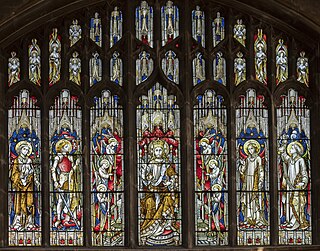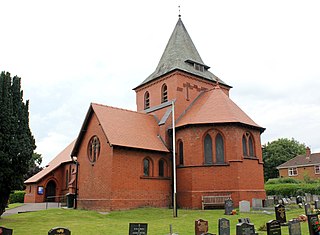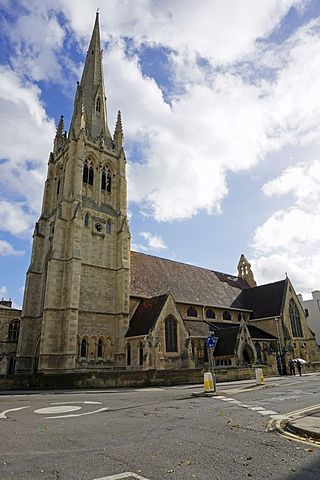
Hardman & Co., otherwise John Hardman Trading Co., Ltd., founded 1838, began manufacturing stained glass in 1844 and became one of the world's leading manufacturers of stained glass and ecclesiastical fittings. The business closed in 2008.

Opus sectile is a form of pietra dura popularized in the ancient and medieval Roman world where materials were cut and inlaid into walls and floors to make a picture or pattern. Common materials were marble, mother of pearl, and glass. The materials were cut in thin pieces, polished, then trimmed further according to a chosen pattern. Unlike tessellated mosaic techniques, where the placement of very small uniformly sized pieces forms a picture, opus sectile pieces are much larger and can be shaped to define large parts of the design.

The Church of Saint Mary the Virgin, commonly shortened to St Mary's, is a church in the Church of England parish of Walmer, Kent, England.

St. John the Evangelist Roman Catholic Church is located on the South Parade in the south-east section of Bath City Centre – the old Ham District where John Wood the Elder, the Georgian architect, had originally planned his gigantic "Forum".

The Pro-Cathedral of the Holy Apostles was the Roman Catholic cathedral in the city of Bristol, England from 1850 to 1973. The Pro-Cathedral was replaced in 1973 by the Cathedral Church of SS. Peter and Paul, also known as Clifton Cathedral. It is a Grade II Listed Building.

St Chad's Church is in Old Hall Lane, Kirkby, Knowsley, Merseyside, England. It is an active Anglican parish church in the deanery of Huyton, the archdeaconry of Liverpool, and the diocese of Liverpool. Its benefice is united with those of St Mark, Kirkby: St Martin, Southdene, Kirkby: and Tower Hill, St Andrew, Kirkby. The church is recorded in the National Heritage List for England as a designated Grade II* listed building.

St. Laurence's Church, Northfield is a parish church in the Church of England in Northfield, Birmingham. The church is in a conservation area near nail maker's cottages, the Great Stone Inn, the old school and the Village Pound.

St Deiniol's Church, Hawarden, is in the village of Hawarden, Flintshire, Wales. It is the parish church of the rectorial benefice of Hawarden in the deanery of Hawarden, the archdeaconry of Wrexham, and the diocese of St Asaph. The church has associations with W. E. Gladstone and his family, and is designated by Cadw as a Grade II* listed building.

All Saints Church, Great Saughall, is located in Church Road in the civil parish of Saughall and Shotwick Park, formerly Saughall and before that Great Saughall, in the county of Cheshire, England. It is an active Anglican parish church in the deanery of Wirral South, the archdeaconry of Chester, and the diocese of Chester. The church is recorded in the National Heritage List for England as a designated Grade II listed building.

St Margaret's Church is in Lonsdale Road, Halliwell, Bolton, Greater Manchester, England. It is an active Anglican parish church in the deanery of Bolton, the archdeaconry of Bolton, and the diocese of Manchester. Its benefice is united with that of Christ Church, Heaton.
Lilian Josephine Pocock (1883–1974) was a stained glass artist who provided stained glass for a number of buildings, including Ulverston Victoria High School, The King's School and Ely Cathedral. She was also a theatrical costume designer, book illustrator and watercolourist. In her later years, failing eyesight prevented her from continuing her work in stained glass. After some years of retirement she died in 1974.

St Francis of Assisi Church is a Roman Catholic Parish church in Birmingham. While the church is located between the Lozells and Hockley parts of the city, the parish covers most of Handsworth. It was founded in 1840, originally as a chapel in the nearby listed building, St. Mary's Convent designed by Augustus Pugin.
The Pippet Family are a family of designers and artists based in Warwickshire and Birmingham, who specialised in Catholic decorative schemes for churches, ecclesiastical metalwork and stained glass windows as well as some textile items. They were part of the British Gothic Revival, notably working for John Hardman & Co in the style of Pugin.

St James' Church is an redundant church in St James' Road, Church, Hyndburn, Lancashire, England. It was an active Anglican parish church in the deanery of Accrington, the archdeaconry of Blackburn, and the diocese of Blackburn until November 2015 when it was closed. The church is recorded in the National Heritage List for England as a designated Grade II* listed building.

John William Brown (1842–1928) was an English painter and stained glass designer. He was employed by Morris & Co. and later by James Powell and Sons, before he became a freelance designer, when he continued to undertake commissions for Powell's. His major works include the Lady Chapel windows and the east window of Liverpool Cathedral.
Ethel Rhind was an Irish stained-glass and mosaic artist, who was associated with An Túr Gloine.

St Gregory the Great Church is a Roman Catholic Parish church in Cheltenham, Gloucestershire, England. It was founded in 1809 and rebuilt from 1854 to 1857. It is situated on the corner of St James' Square and Clarence Street. It was designed by Charles Hansom and is a Grade II* listed building.

Immaculate Conception Church is a Roman Catholic Parish church in Spinkhill, Derbyshire, England. It was built in 1846 and designed by Joseph Hansom. It is situated on Spinkhill Lane opposite Immaculate Conception Catholic Primary School south of Mount St Mary's College in the village. It was founded by the Jesuits and is a Grade II listed building.
Hubert Vincent McGoldrick was a Dublin-born stained glass artist, one of a small number of Irish artists which included Michael Healy, Wilhelmina Geddes, Evie Hone, and Harry Clarke, who worked in this medium and achieved international recognition for their work in the first half of the 20th century. His career at An Túr Gloine spanned from 1920 until 1943; thereafter he produced very few works in the medium. Along with Ethel Rhind and Catherine O'Brien he was one of the artists at the studio who worked in opus-sectile mosaic, a side-line of the studio. Hubert McGoldrick was also an occasional illustrator and his most recognised illustration is the Magnificat Anima Mea Dominum created for the Legion of Mary.

St John's Church, in full the Church of St John the Evangelist, is a Church of England church in the Boreham area in the south-east of the town of Warminster, Wiltshire, England. It was built in 1865 and is a Grade II* listed building.
















